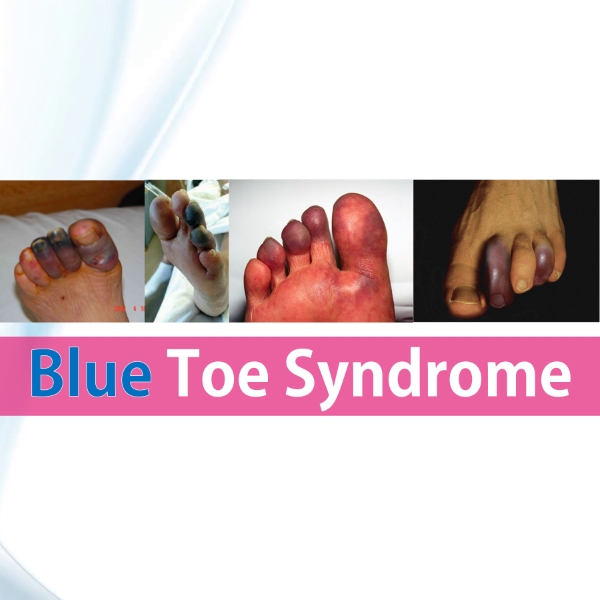
Blue Toe Syndrome
Newsletter Blue Toe Syndrome What is Blue Toe Syndrome? Occlusive vasculopathy, often known as blue toe syndrome, is a kind of acute digital ischemia in which one or more toes turn blue or violet in color. Petechiae or cyanosis of the soles of the feet may be present in isolated areas. There may also be scattered areas of petechiae or cyanosis of the soles of the feet. Blue toe syndrome (BTS) is characterized by painful digits with a blue or purple discoloration that does not occur as a result of direct damage. It can also result in the amputation of toes and feet, which can be fatal. Pathophysiology Acute digital ischemia manifests itself as blue toe syndrome. This means that happens when the blood supply to the toes is inadequate. One or more of the following factors can cause a reduction in blood flow: Decreased arterial flow Impaired venous outflow Abnormalities in circulating blood. The blood transports oxygen from the lungs to every part of a person’s body. To repair and multiply, each cell requires oxygen. The blood also transports waste products and provides all of the nutrients that cells require. Inadequate blood supply damages cells and the tissues that they make up. This might cause the tissue to turn blue or purple in color. The condition is known as blue toe syndrome when it affects the toes. Some people with this condition have just one discolored toe on one foot. Others might have discolored toes on both feet. Some people will find that the toes go back to their normal color when they put pressure on the skin or when they elevate their foot. Click the button below to download Pathophysiology Made Easy eBook. This eBook has 12 chapters and 234 pages. Sample of Pathophysiology Made Easy Flashcards eBook Download Now Symptoms Blue toe syndrome can cause the following symptoms in addition to blue or purple toes: Moderate or severe forefoot pain Leg muscles pain Ulcers on the feet Nodules or lesions on the feet Bruising Causes of Blue Toe Syndrome When a blockage in the small blood vessels in the foot prevents the tissues from receiving enough blood, blue toe syndrome develops. Blue toe syndrome can be caused by a variety of factors. Atherosclerosis Cholesterol is a waxy molecule that the body requires to produce hormones, vitamin D, and other digestive aids. The body produces all of the cholesterol it requires, but it is also found in foods such as eggs, beef, and cheese. When blood cholesterol levels are excessively high, it can combine with other chemicals to produce plaque. When plaque adheres to the artery walls, it narrows them, resulting in atherosclerosis. Plaque can also obstruct the flow of blood through the arteries. Embolism When something blocks a blood vessel, it is called an embolism. Plaque fragments can break out from the arterial walls and move through the bloodstream until they become lodged. Blood clots can do the same thing. Embolisms can develop spontaneously or as a result of an angiography, vascular surgery, medicine, or renal failure. Angiogram An angiogram is a form of medical imaging. Doctors use it to detect and treat blood artery blockages and atherosclerosis. A needle is inserted into an artery in the groin, and thin tubes called catheters are threaded through the arterial system. While injecting a contrast agent into the bloodstream, the team will take X-ray photographs of the person. This chemical aids in the detection of any obstructions or other difficulties. The operation can sometimes knock a fragment of plaque off the artery walls, causing blue toe syndrome, according to researchers. Vascular surgery Any procedure on the circulatory system is referred to as vascular surgery. The arteries, veins, and lymphatic system are all part of this system. Embolisms are a possible side effect of vascular surgery. A plaque fragment, blood clot, or other particles might circulate in the bloodstream until it becomes lodged in a blood vessel. Blue toe syndrome can arise when this happens in the foot. Inflammation caused by infectious and non-infectious agents Syphilis, pyogenic infection (sepsis), Behçet illness, and various types of vasculitis can all cause occlusion. Impaired venous outflow Phlegmasia cerulea dolens is caused by abnormal venous drainage along with severe venous thrombosis (a painful form of blue toe syndrome associated with leg oedema). Predisposing factors for venous thrombosis exist in many people, including: Immobility Clotting disorders Pregnancy Previous leg trauma Malignancy Circulating blood abnormalities Abnormal blood components can cause blue toe syndrome. These includes: Cryoglobulinaemia Platelet plugging Myeloproliferative disorders (eg, polycythaemia rubra vera and essential thrombocythaemia) Cryofibrinogenaemia Paraproteinaemia (which causes hyperviscosity) Cold agglutinin anaemia Paroxysmal nocturnal haemoglobinuria Medications Medicines used to thin the blood or cure blood clots, according to the European Society of Cardiology, can also cause blue toe syndrome. Cocaine and other recreational drugs can potentially cause the condition. Renal failure The kidneys play several roles in the human body: Removing waste products from the bloodstream and disposing of them in the urine Ensuring that the blood contains the proper balance of nutrients that cells require, such as sodium, potassium, and calcium Produces hormones that regulate blood pressure and red blood cell production Renal failure occurs when the kidneys are unable to function normally. According to the European Society of Cardiology, this condition can lead to blue toe syndrome Download ALL STUDY RESOURCES in Medicine & Surgery Diagnosis The clinical diagnosis of blue toe syndrome is based on the patient’s history and examination findings. To guide treatment, it’s essential to figure out what’s causing blue toe syndrome in the first place. The clinical examination usually provides clues, but more investigation in the form of laboratory blood tests, tissue biopsies, and radiographic imaging is required to confirm the diagnosis. History and examination should focus on: Hypertension or other risk factors for hypercholesterolaemia and atherosclerotic diseases Fever (indicating cholesterol emboli, infective endocarditis, myxoma, thrombotic thrombocytopenic purpura, and disseminated intravascular coagulation) Cardiac murmur (infective endocarditis and atrial myxoma) Livedo reticularis (cholesterol emboli, myxoma, antiphospholipid syndrome,
Read More
